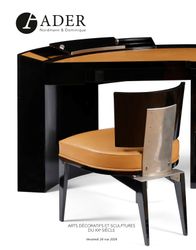
Friday 24 May at
: 14:00 (CEST)
20th-century decorative arts and sculpture
We are sorry, the auction is over.
Exhibition of lots
vendredi 24 mai - 11:00/12:00, Salle 1-7 - Hôtel Drouot
jeudi 23 mai - 11:00/20:00, Salle 1-7 - Hôtel Drouot